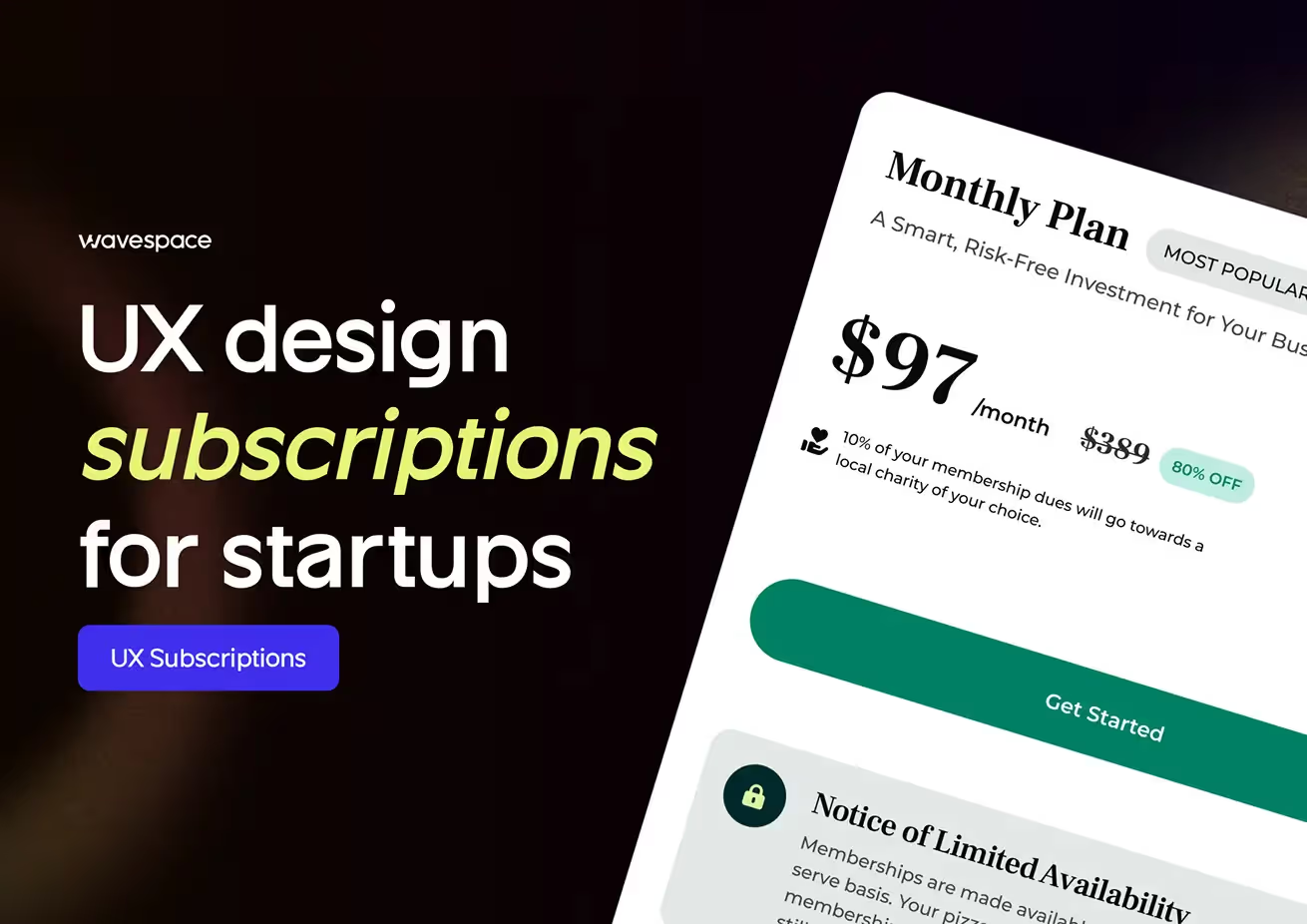Top 15 Banking Apps with Exceptional UX Design (2025)
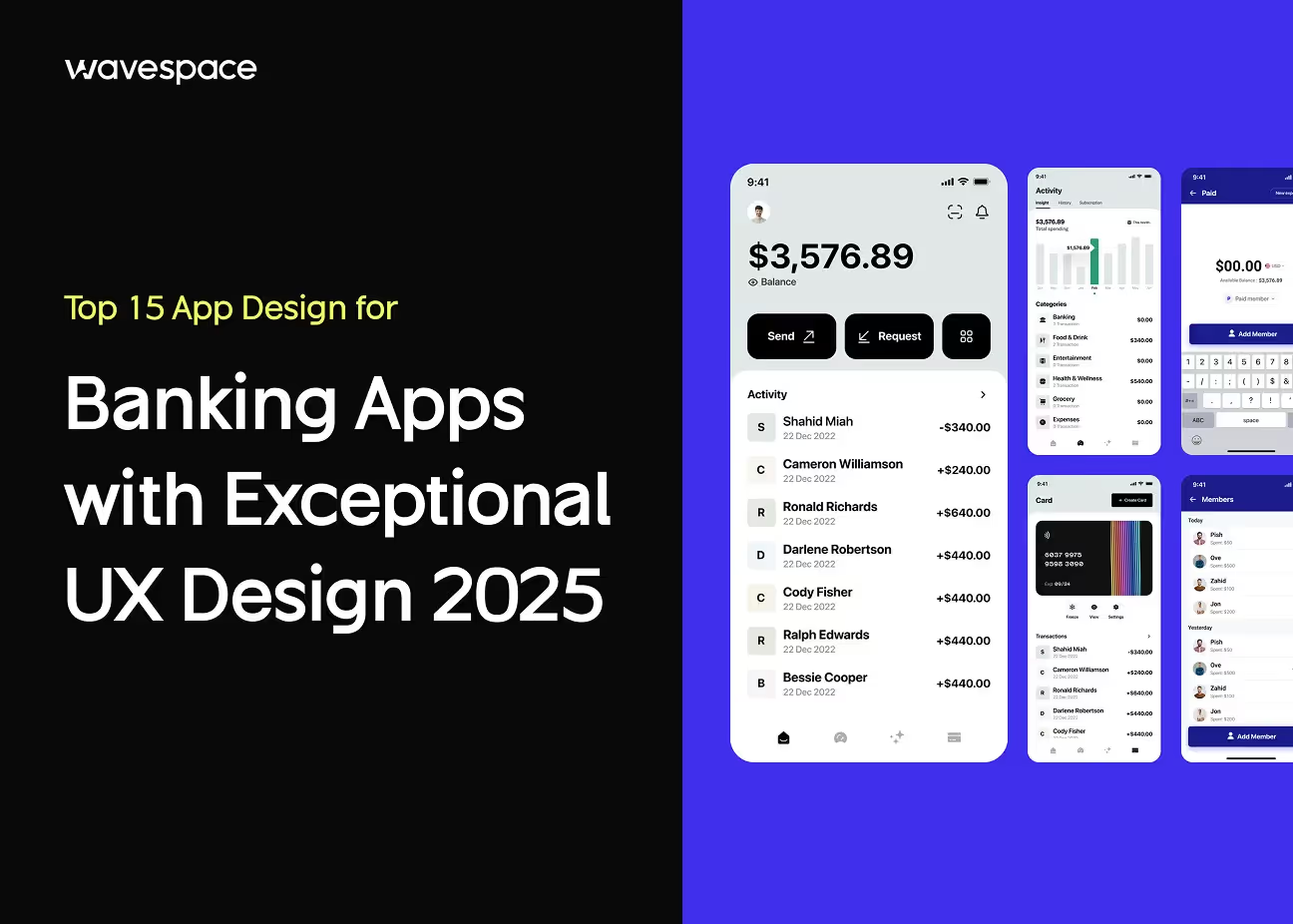
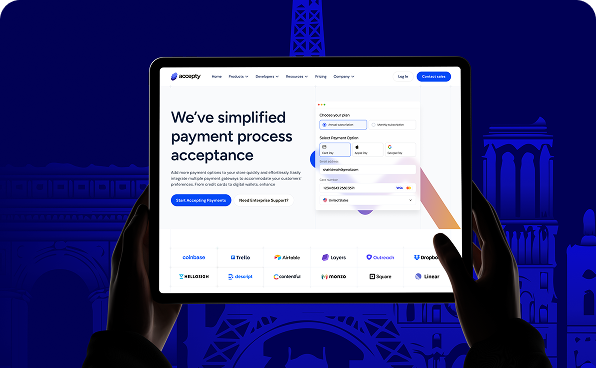
Ever opened a banking app and felt like you needed a manual just to find your balance?
That one moment tells a lot about what UX is missing in fintech. By 2025, the user experience will demand that apps feel spontaneous and intuitive, even a bit joyful.
UX design is now the backbone of digital banking. They control costs, request loans, and even open their wallets, all with the tap, swipe, and screen touch. When done well, good UX creates trust, stages reduction in friction, and provides clarity and a sense of control to its users.
So, what does exceptional UX in banking apps look like? Consider quick onboarding, user-friendly design, intelligent feedback, and a UI that does not feel like the result of a template. These aren’t extras anymore. They’re the new baseline.
We compared fifteen outstanding apps on the basis of onboarding, usability, personalization, emotional satisfaction, and features to build trust to reveal what works in the current leading banking experiences. Each one in this list doesn’t just meet expectations, they raise the bar.
Do you develop a fintech product or want to redesign UX or UI? This guide will provide you with working insights and well-proven patterns. When you are willing to create an outstanding experience, read about our UI/UX design service, or follow other examples on our blog.
Key UX Trends Shaping Banking Apps in 2025

In 2025, banking applications are not only tools to work with, they are also smart companions to guide the user in the intricate universe of finance. These UX trends reveal the way banking applications are changing and becoming more useful, safe, and fun.
1. Mobile-First & Responsive Design
Banking today is mobile-first by default. People wish to see their balance on the metro or send money over lunch, and the process should feel seamless each time. Good apps fit any size of screen, including phones, tablets, and desktops. It is easy to navigate since touch gestures, swipeable cards, and adaptive layouts are available. To cover every context, designers pay attention to thumb-friendly areas, a few taps, and adaptable grids. A good app is not only convenient, but it is also required to make an app trustworthy.
2. Smooth Onboarding & Guided Flows
Long forms? Password setup hurdles? They’re out. Modern onboarding is conversational, assisted, and fast. It could be ID scanning, biometric, or phone data import from another bank; whatever the case is, users anticipate an invisible log-in. Great UX here reduces drop-offs, builds early momentum, and creates a sense of progress. The most optimal flows rely on real-time feedback, dynamic fields, and non-misleading microcopy. The goal? Create an impression that users have control over everything from the very first tap.
3. AI-Powered Personalization & Chatbots
AI in banking UX is now table stakes. AI can deliver educational and emotionally fulfilling experiences because of chatbots, allowing you to retrieve forgotten pins and dashboards that propose saving objectives. Algorithms analyze behavior to show spending insights, recommend offers, or anticipate financial needs. Its magic is in the fact that users are not being watched, but rather understood. Good chatbots communicate in simple terms, keep the context, and intelligently escalate. When use right AI will make banking more human, not less.
4. Instant Payments & Microinteractions
Speed matters. When a user clicks "send," they expect a response immediately, not only mechanically but also visually. Microinteractions such as small animations, checkmark animations, bounce effects, or progress bars offer emotional gratification. These are not only aesthetics, but also create credibility. Microinteractions such as small animations, checkmark animations, bounce effects, or progress bars offer emotional gratification. Great banking apps minimize all the friction throughout the transfer process, making actions a good feedback loop.
5. Biometric Authentication & 2FA
Security no longer means friction. Fingerprints or Face ID are biometric choices that will make it almost immediate. Two-factor authentication (2FA) with device prompts, email links, or biometric fallback has become seamless. Top apps create invisible layers of trust in place of confusing users with codes or redirects. And with cyber threats increasingly on the rise, the task becomes how to make protection seem seamless.
6. Voice Banking & Accessibility
Banking is for everyone, including those with visual, motor, or cognitive challenges. That’s why top apps invest in voice control, high contrast modes, larger tap zones, and screen reader support. Voice (enabled) banking assists mobile users as well. It should be as easy as saying, texting to say transfer 50 dollars to Sarah. The UX is not about being accessible; it is a core component of UX. In 2025, inclusive design isn’t just good ethics, it’s good business.
7. API Integrations & Financial Ecosystem
Users expect their banking apps to integrate seamlessly with other services. That means integrations with accounting platforms, tax tools, wallets, payroll systems, and more. APIs now connect personal finance to the larger ecosystem of work and life. When it works, this makes it seem that a system center is central, rather than only isolated. UX should be able to facilitate deep integrations without clouding the main issue.
8. Crypto & Blockchain Features
With crypto going mainstream, users want control over their digital assets from one place. When you track NFT prices or send tokens, the user experience (UX) should make complex systems easy to understand. Price feeds need to be in real-time, wallet balances, and clear transactions are needed. Blockchain can offer secure identification of IDs and smart contracts as well, and all these require user-friendly flows. The challenge is simplifying without dumbing down.
9. Social Banking & Shared Finances
Money isn’t always private. Social features are needed in group trips, collective rent, and family budgeting. Among the most popular apps, there are now bill-splitting, shared goal-setting, and payment feeds. These experiences must balance fun and function.
Can everyone see their part? Who paid last? How do you remind without being awkward? Answers to these questions in UX create harmony and make users keep coming back.
Together, these trends show how far banking UX has come and where it’s heading. The best apps will not simply manage money as finance becomes greater integrated into daily life. They’ll feel like partners in life’s journey.
Common UX Challenges Banks Face
Creating an excellent banking app UX isn’t easy. In real life, both the designers and product teams encounter challenges, particularly in conventional financial institutions. Here are the top roadblocks:
Regulatory Compliance
- Each financial product has to comply with national and international regulations.
- Rules of KYC, AML, and GDPR demand very rigorous verification and protection of user data.
- This adds constraints on signup flows, identity checks, and data display.
Great designers know how to make compliance feel invisible, with secure document scanning, in-app explanations, and progressive onboarding.
Security vs. Simplicity Trade-Offs
- The biggest UX balancing act in finance: make it secure without adding friction.
- Passwords, 2FA, and identity checks are required.
- However, there are too many obstacles that result in drop-offs.
The solution: face ID, biometric login, location-based verification, and smart defaults that serve the users in a trusted direction.
Legacy System Integrations
- Many banks rely on outdated backend infrastructure.
- New front-end design layers are often patched on top of old APIs.
- This establishes latencies and fragmented services as well as non-predictable use of the UI. That is why even super famous banking apps can be slow or cluncky.
UX teams need engineering, security, and compliance collaboration to be able to understand the experience with reality.
Cost and Time of Innovation
- Redesigning banking experiences isn’t cheap.
- It requires product, legal, dev, and marketing all on the same page.
- Startups can be nimble, legacy banks commutative.
The methodology should empower designers to achieve quick wins and MVPs while demonstrating the long-term ROI of design, similar to how top MVP development agencies create impactful solutions.
Cross-Platform Consistency
- Banking apps need to be universal on iOS, Android, web, tablet, and perhaps smartwatch.
- The UI guidelines and user expectations differ on every platform.
- A button on iOS behaves differently from Android; layout priorities vary by screen size.
- The challenge is to build a design system that adapts but feels unified.
They are not easy challenges. Now, in the following section, we are going to look at 15 banking apps that were able to overcome these pitfalls through clever UX design and emerge to be the best in the business.
Why UX Design Matters in Banking Apps
Managing money is emotional. It comes along with pressure, mistrust, and a desire to keep things simple. An effective banking application not only works, but also gives confidence. A great banking app UX builds trust by:
- Offering clear, fast onboarding
- Providing real-time feedback on actions
- Using simple, encouraging language
- Making security seamless, not stressful
By 2025, users expect more than functional tools. They desire thinking processes, valuable input, and designs that acknowledge their time. This isn’t about trends, it’s about building digital trust with human needs in mind. So let’s explore what the best in class are doing.

List of 15 banking apps with top UX design
Top 15 Banking Apps with Exceptional UX Design (2026): What Sets Them Apart
The methodology should empower designers to achieve quick wins and MVPs while demonstrating the long-term ROI of design. Explore how top MVP development agencies are creating impactful solutions to achieve this balance.
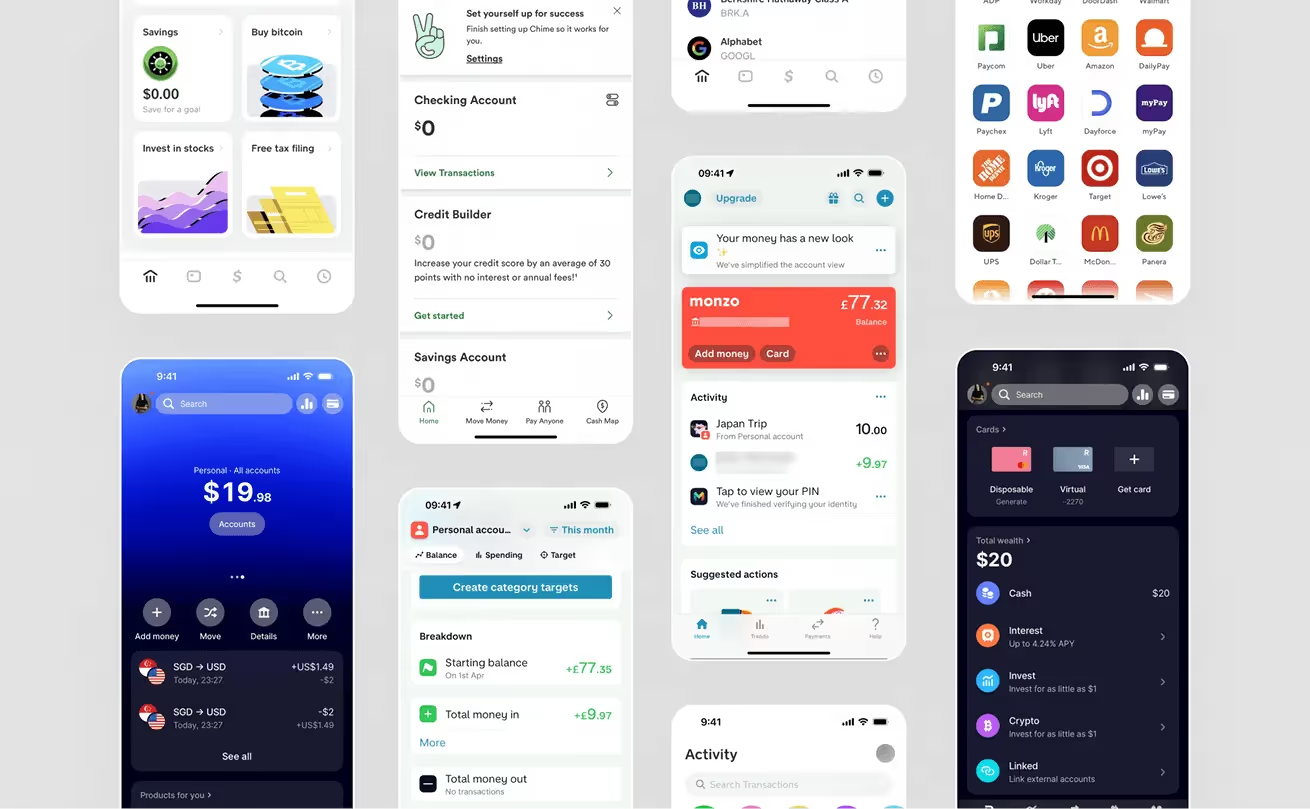
1. Revolut
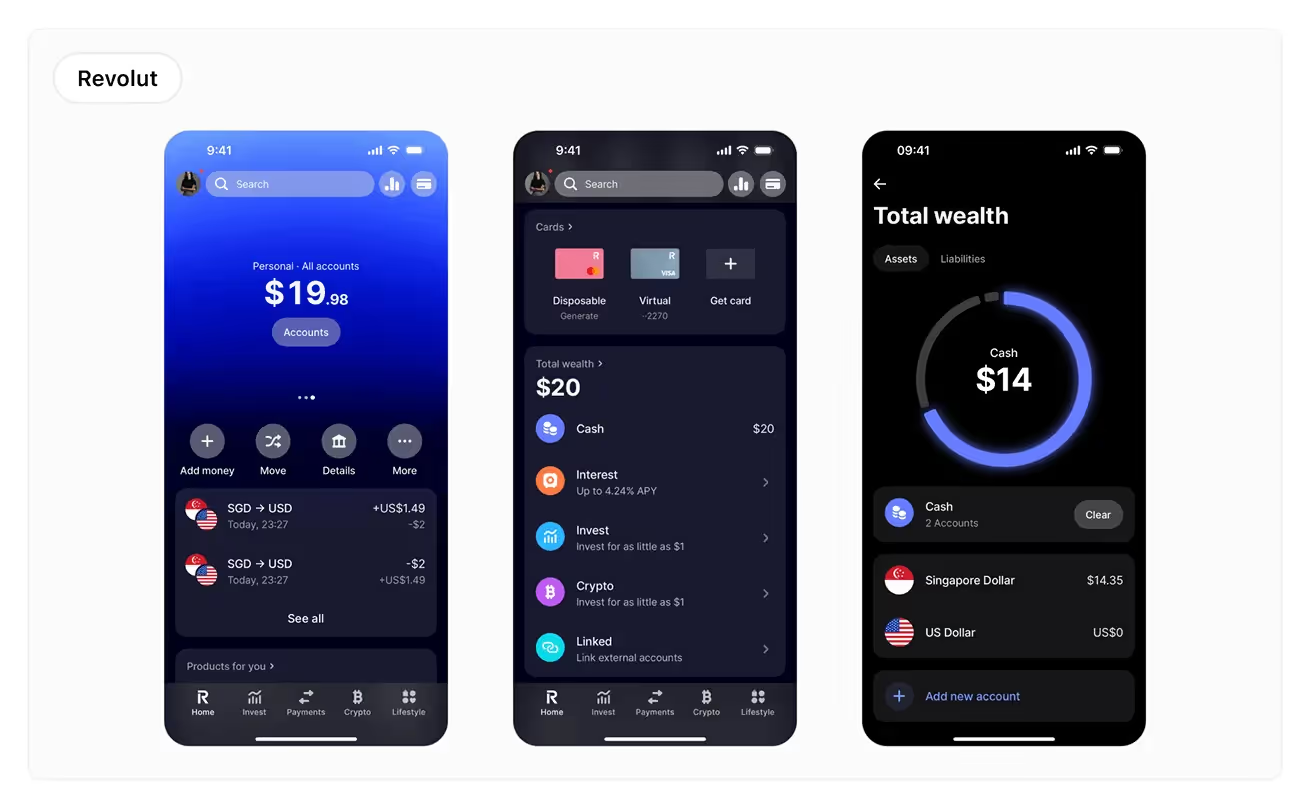
Revolut has a reputation for integrating the features of international banking with digital convenience. Users can use the app to trade currencies, maintain multinational accounts, and use premium cards without much friction. Every screen is optimized for action. It goes through the onboarding quickly enough, and the division of features is refreshingly easy to navigate. The UI has a lot of white space, heavy icons, and real-time responses, which develop trust in a financial setting.
- Instant card freeze/unfreeze
- Real-time currency conversion
- Bold CTAs with clear hierarchy
2. Monzo
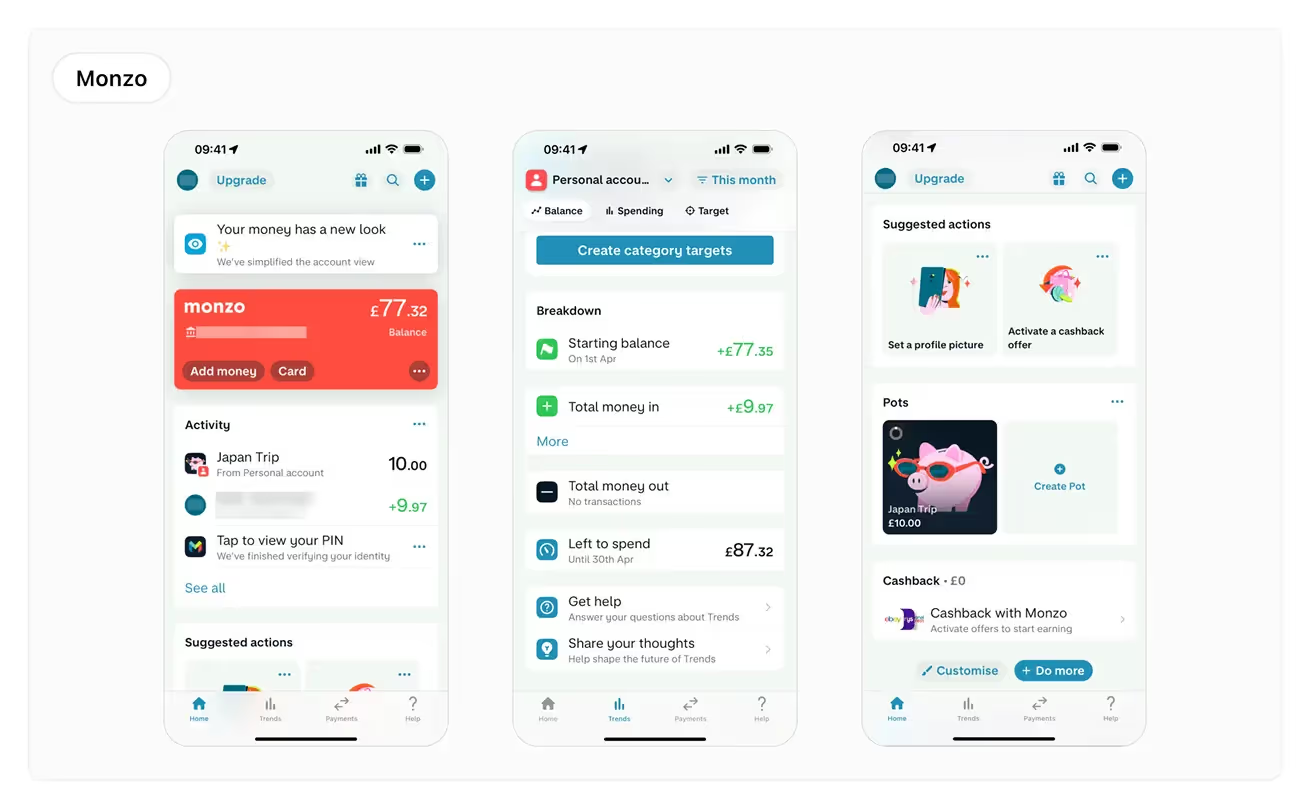
Monzo makes banking feel human. The app is not only a tool, but it also provides insight with the luminous language of design, the pleasant tone, and even the learning prompts. From intuitive savings pots to push notifications that nudge positive habits, Monzo has built a community around clarity and emotion. Each interaction feels like it was built for real people, not accounts. Visual hierarchy makes it clear what to do, and little details such as handmade emojis add individuality to the experience.
- Playful microcopy and tone
- Visual savings pots and budgeting tools
- Clear financial breakdowns on the home screen
3. Chime

Chime delivers a focused mobile-first experience built around speed, simplicity, and financial freedom. Users get to keep track of what they spend, can get a direct deposit early, and can check balances in real-time, all on an interface that seems clear and comforting. Chime is especially effective in keeping intimidation levels down, typical of banking applications. Its typography, white space, and friendly icons create a calming, low-friction experience, especially valuable to younger or less technical users.
- Simple direct deposit setup
- Clean home interface
- High accessibility (text sizes, color contrast)
4. Nubank
Nubank represents how powerful localized design can be. Based in Brazil, it serves millions with an elegant, mobile-first platform that puts people before features. All the screens have regional preferences built into them, including payment options and color selection. The app feels smart, stable, and secure without feeling sterile. This is because users appreciate its simplicity in handling bills, sending money, and monitoring their finances on a warm, minimalistic interface.
- Color-coded expenses
- Goal setting and intuitive bill tracking
- Lightweight motion transitions
5. N26
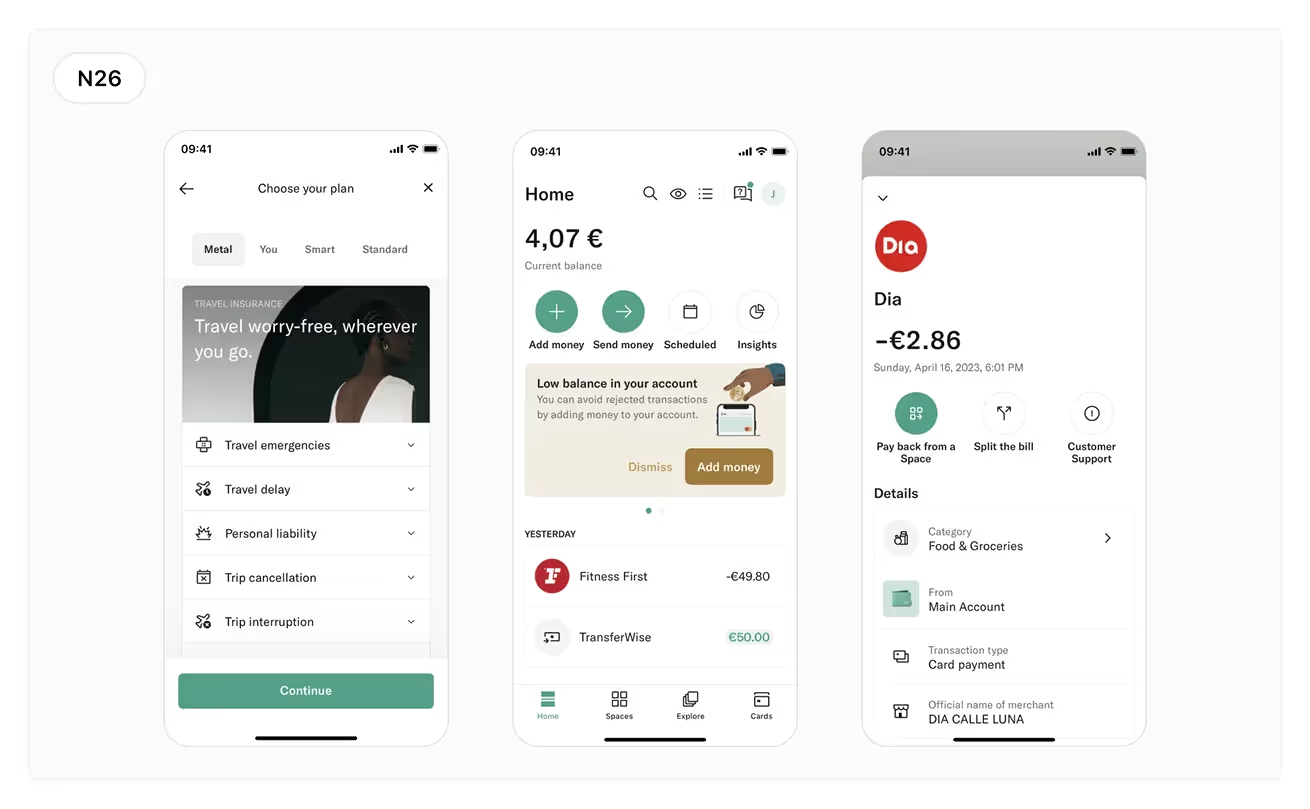
N26 combines minimal aesthetics with rapid functionality. The app gives users total visibility into their financial health through beautifully organized screens. Each transaction is grouped and labeled automatically. Access to support and insights, card management is also no more than two taps away. N26’s success lies in how it makes everyday banking feel effortless without dumbing down the experience. It’s what modern minimalism should look like in fintech.
- Transaction timelines
- Bottom navigation with intuitive flow
- Instant card control and usage notifications
6. Starling Bank
Starling creates an enterprise-grade UX for everyday users. Supporting personal and business accounts, it provides powerful features with a well-designed UI. Users are allowed to customize dashboards, set up savings automation, and control cards. Among the outstanding features is the Spaces that allows customers to keep funds apart and visualize them. Every element in the app feels intentional and calm, reinforcing the brand’s message of trust and clarity.
- Drag-and-drop money transfers
- Personalized spending insights
- Simple account switcher
7. Ally Bank
Ally’s UX design is clear, consistent, and user-centric. It has a legacy in conventional banking moved successfully to digital-first fronts. The application offers strong functionality, including planning, investment monitoring, and help chat with a user-friendly structure. Ally excels in designing for accessibility. High contrast colors, readable font types, and contextual instructions accommodate all users. It is all thought-through, not hasty or plagiarized.
- High-contrast design
- Accessible tooltips
- Clean interface across both desktop and mobile
8. SoFi
SoFi brings together banking, loans, investing, and credit building into a single unified experience. Despite its range, the app never feels bloated. Dashboards are clear and modular, allowing users to visualize financial progress. When you are checking your student loan balance or building a new savings vault, every screen slides with clarity. The tone is empowering. SoFi presents itself as a financial coach at the nudge of subtle coaching and the guidance of progress marks.
- Personalized financial planning dashboard
- In-app advice prompts
- Modular layout based on needs
9. Cash App
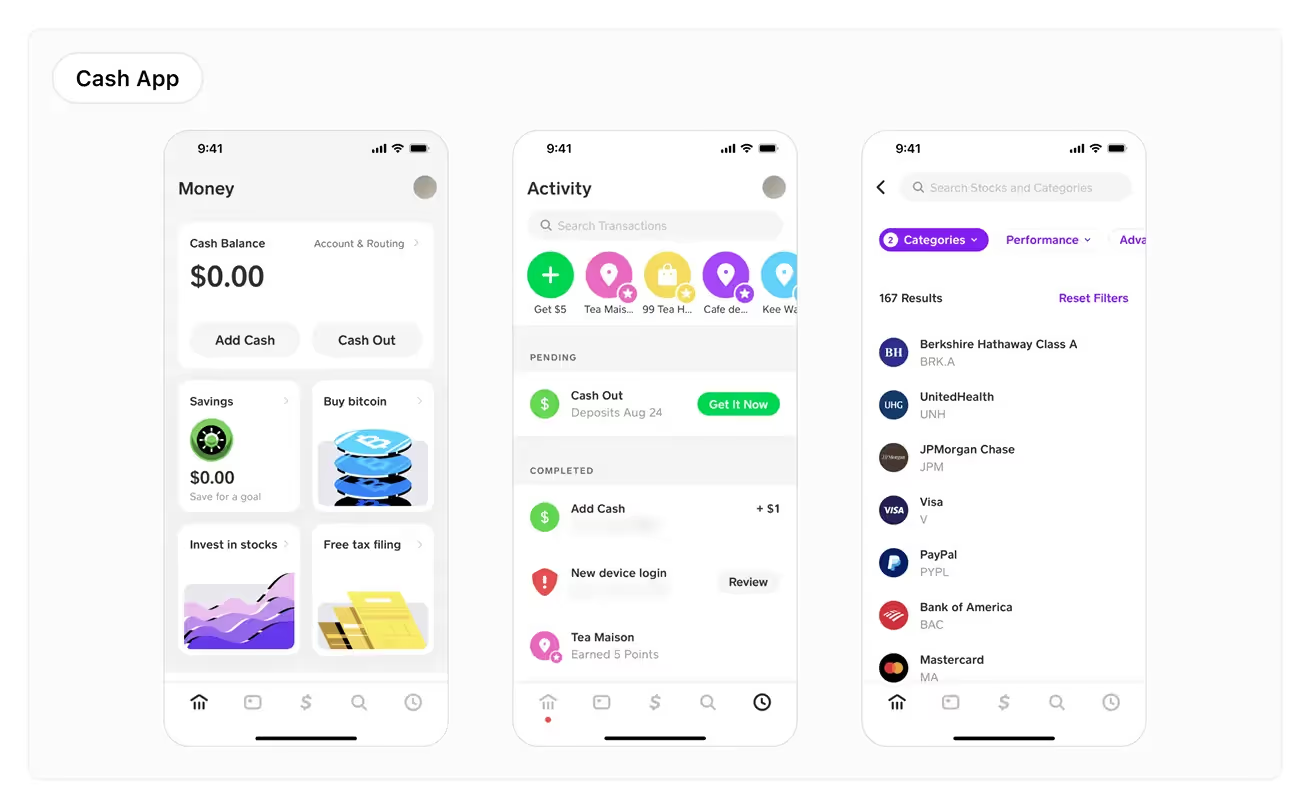
Cash App is the definition of bold, modern UI for Gen Z users. It has bold colors, oversized buttons, and chatty flows, which are features that are unique in a category that is prone to dry designs. Sending money, receiving paychecks, or buying Bitcoin takes seconds. However, the brilliance lies in the fact that the personality of the app has been retained, but the actions are streamlined. You don’t need onboarding videos, just a thumb and curiosity. The design earns trust through clarity and speed.
- 2-tap money transfers
- Custom payment pages and cards
- Youth-focused emoji and gradient styling
10. Wise
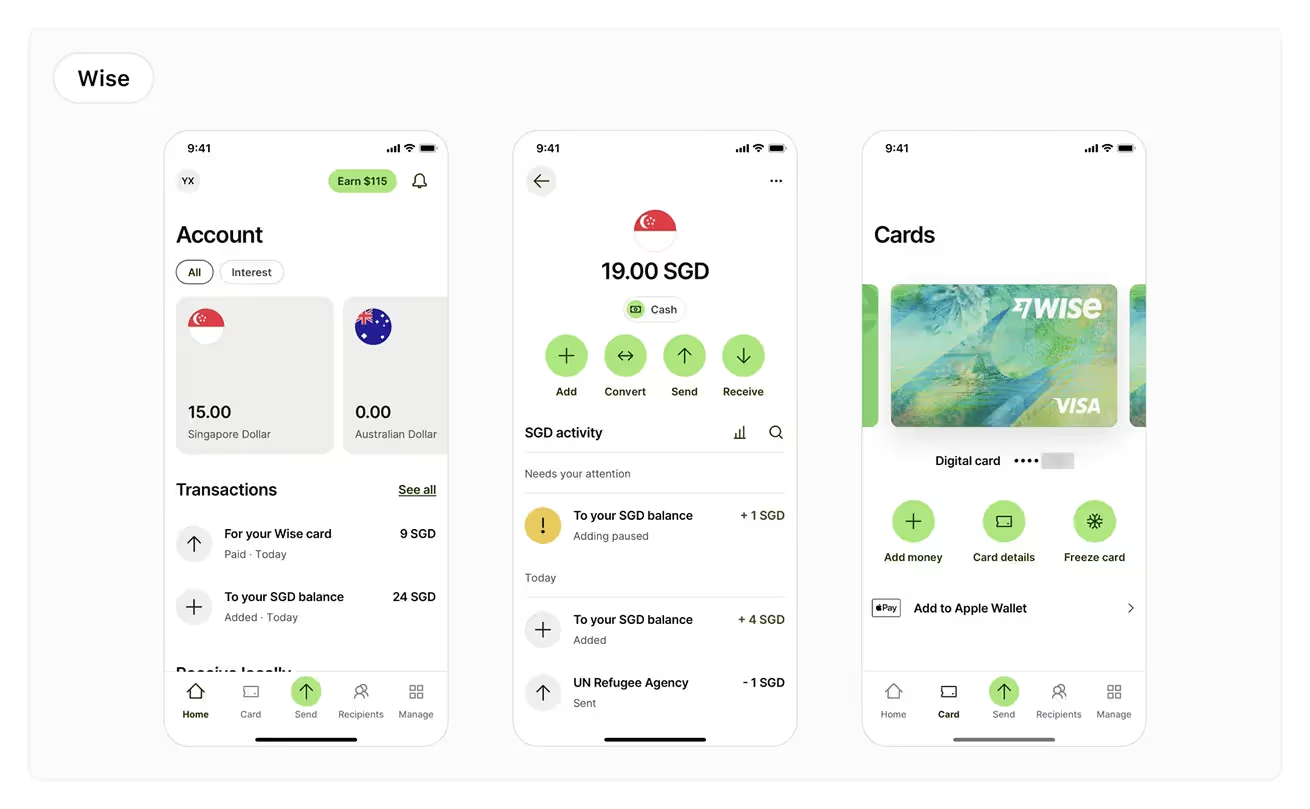
Wise focuses on international money transfers, and its UX delivers transparency as its superpower. Each transfer indicates clearly the cost, the fees, and when the funds will be received. The app does not use technical terms and validates actions using real-time feedback. For a global audience, localization and simple explanations make Wise stand out. They also employ charts, movement ,and subtle alerts to identify with a stress-free transaction process.
- Live exchange rate display
- Transparent fee UI
- Intuitive account switching
11. Paytm
Paytm is one of India’s most versatile apps, offering everything from bill pay to booking cinema tickets. The question is how to keep all this usable, and Paytm achieves it with the help of a reasonable visual hierarchy and an icon-driven navigation system. Users can find key actions without reading long menus. It is inclusive with language choices and availability of local payment flows. It is quick to load and easy to operate despite its feature set.
- Icon-first UI for easy access
- Seamless bill payments and QR scanning
- Multilingual interface support

12. Venmo
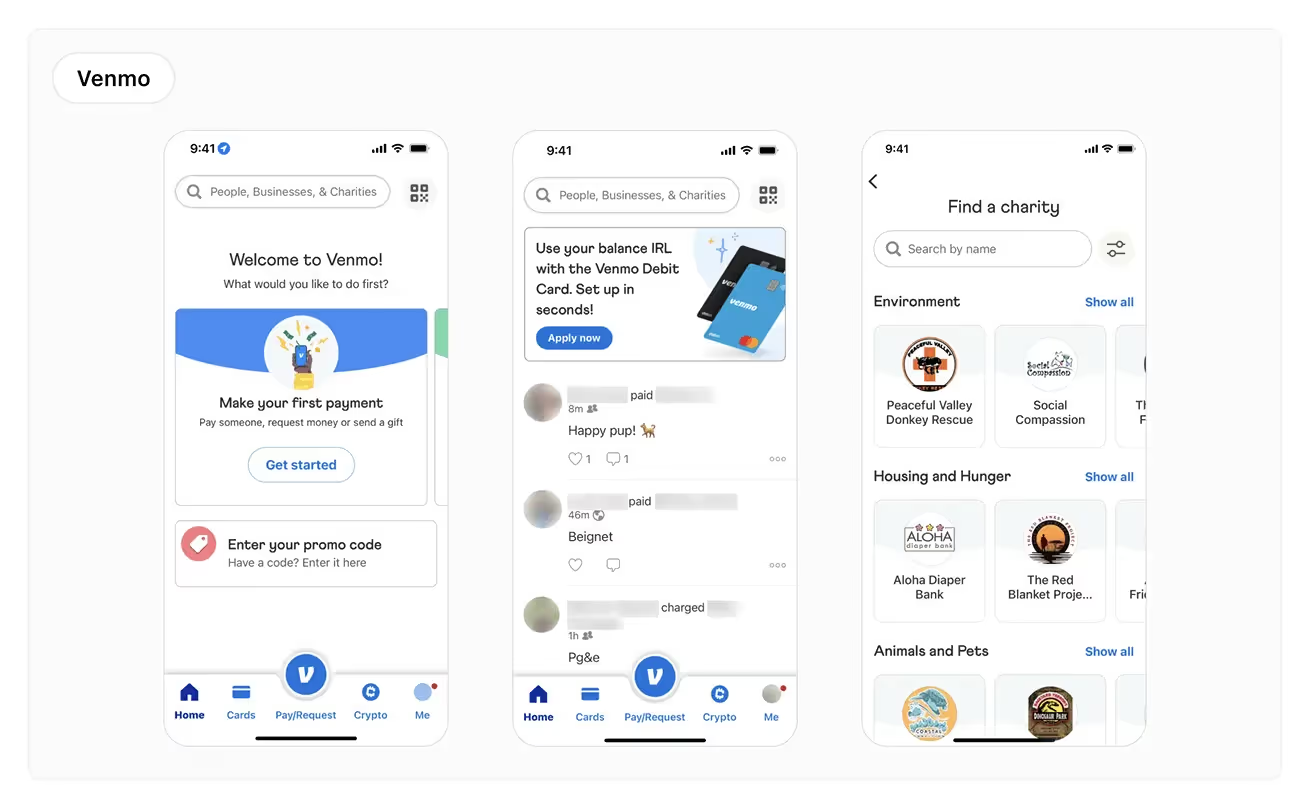
Venmo mixes utility with social delight. It turns money movement into a shared experience. Users can comment on payments, view feeds, and like transactions. This adds fun, but also emotional engagement. Venmo makes it easier to engage in repetitive behaviors such as paying a bill or sending birthday cash with reusable flows. The app makes all this informal and yet safe and reliable. That’s a rare balance, and Venmo gets it right.
- Payment feed with comments and emojis
- Simple group splits
- Easy sign-up and card sync
13. UBank
UBank emphasizes emotion and support in its financial UX. The app uses a conversational tone to encourage users to plan, save, and reflect. Goal-setting features are never mechanical or mathematical; they are human. Clean charts and previews of the data in the app also reduce the horror of financial data. With soft edges, intuitive swipes, and simplified tasks, UBank creates a space where finance feels approachable.
- Chat-style goal setup
- Card design previews
- Soft, calming color palette
14. Dave
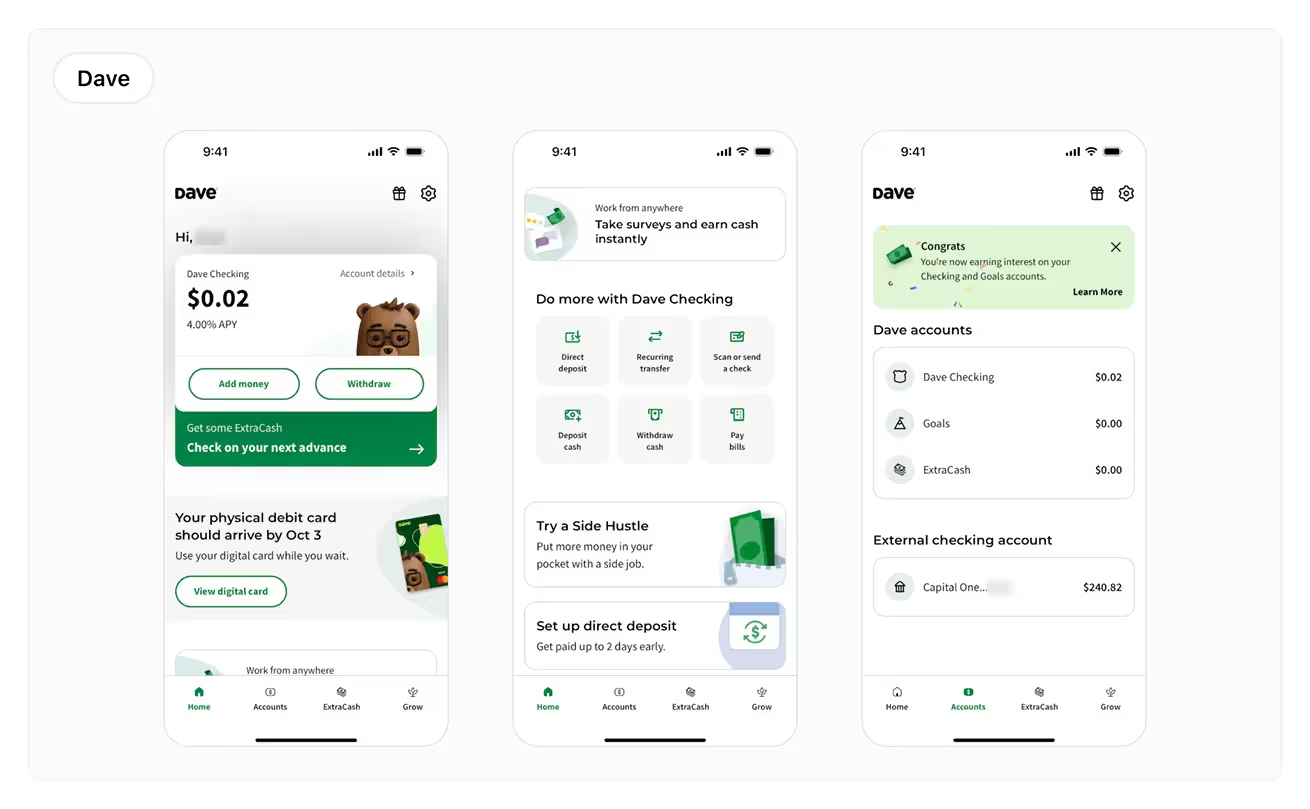
Dave is built for financial survival and small wins. It supports users who may struggle with credit, unexpected bills, or limited income. That audience deserves dignity, and Dave delivers it. The interface avoids judgmental language and instead emphasizes progress. Advance requests, budget tracking, and side hustle discovery are all within a few taps. Even the brand mascot adds comfort without feeling childish.
- Friendly tone of voice
- Easy-to-use advanced request UX
- Built-in side hustle tools
15. Bank of America
Bank of America has done the hard work of modernizing a legacy system. Their digital assistant “Erica” makes everyday banking smarter with personalized prompts. This system adds layers of complexity, bill payment, card management, and investment tools to flows that are easy to access. This interface is very relaxed and ordered, and hence it is attractive to both old and young people. Overall, biometric logins, timely alerts, and visual dashboards keep things on track with minimal clicks.
- “Erica”, virtual assistant
- Smart alerts and insights tab
- Biometric login and facial ID
What We Can Learn from the Best
In all these 15 apps, a handful of common UX design principles emerged, which informed everything, including the home page layout and payment flows:
- Clear task flows: Every action, from account creation to fund transfer, follows a smooth, step-by-step logic.
- Trust-building visuals: Practical employment of blanks, expected arrangement of calls to action, and a hierarchy that makes sense.
- Instant feedback: Confirmation on the screen, feedback on a handling response, or some contextual assistance satisfies the users with each formula.
- Responsive to user types: The interface will ease the experience of both first-time users and experienced investors.
- Emotional connection of tone: Monzo and Chime apps are using the language that sounds supportive, friendly, and even human.
Similar patterns kept cropping up among the best performers:
- Personalization through financial insights, spending goals, and adaptive dashboards.
- The gamified characteristics of savings bring fun and develop the habit.
- Financial coaching tools are seamless, and they guide users into smarter decision-making.
The takeaway? The moment you adopt clarity and empathy to UX, users have more trust, linger time, and speak in favor of your brand. As a founder or a designer, learning what works in these best apps can revolutionize the way you create your product on the first day.

Final Thought
The future of banking app UX is simple, fast, and trust-building. This is not simply adding as much as possible; it is making money so easy to deal with.
As fintech grows more competitive, UX becomes the true differentiator. These apps on the list are what happens when teams design meaningfully, test with real people, and center what is most meaningful.
Design is not just about how it looks, but how it works and how it makes people feel. So, when building or updating your banking app, keep this in mind. Discover how Wavespace can assist your team. Let's create something that both people and businesses can truly connect with.
Frequently Asked Questions (FAQs)
What is banking app UX?
Banking app UX (user experience) refers to how a user feels while interacting with a banking application. This includes everything from such things as navigation and task flows, to visuals, microinteractions and emotional feedback. A great banking app UX makes managing money feel easy, secure, and even enjoyable. It minimizes user friction while increasing trust and confidence.
Why is UX important in banking apps?
Since money is an emotional and sometimes stressful subject, the users do not need to have their stress levels increased by using a financial app. UX contributes to building trust, directing a customer through a multi-step process, and making them willing to come back. In 2025, users expect smooth onboarding, instant responses, simple navigation, and clear visuals. A good UX keeps users engaged and loyal.
Which banking apps have the best UX in 2025?
Apps like Revolut, Monzo, Chime, Nubank, and N26 are leading the pack with outstanding UX. They offer familiarity, convenience, trust-inspiring design, and intelligent personalization to provide an intelligent, easy money experience. Each of the 15 apps on this list represents a high standard of modern UX design.
What are the key UX trends in banking apps?
Among the largest trends in 2025 are mobile-first design, AI-enabled insights, biometric authorization, voice banking, microinteractions in real-time, and the inclusive design. These trends show how banking apps are evolving to become more responsive, secure, and emotionally supportive.
How can I improve the UX of my fintech product?
Begin by making the important processes, such as onboarding and payment, simple. Make it time sensitive, clear architecture, and human language. Focus on clarity, trust, and accessibility. Study top apps like Monzo or Wise for patterns that reduce friction. Or explore how UI/UX design services can help you deliver a seamless, world-class experience from the start
Top 15 Banking Apps with Exceptional UX Design (2025)

Ever opened a banking app and felt like you needed a manual just to find your balance?
That one moment tells a lot about what UX is missing in fintech. By 2025, the user experience will demand that apps feel spontaneous and intuitive, even a bit joyful.
UX design is now the backbone of digital banking. They control costs, request loans, and even open their wallets, all with the tap, swipe, and screen touch. When done well, good UX creates trust, stages reduction in friction, and provides clarity and a sense of control to its users.
So, what does exceptional UX in banking apps look like? Consider quick onboarding, user-friendly design, intelligent feedback, and a UI that does not feel like the result of a template. These aren’t extras anymore. They’re the new baseline.
We compared fifteen outstanding apps on the basis of onboarding, usability, personalization, emotional satisfaction, and features to build trust to reveal what works in the current leading banking experiences. Each one in this list doesn’t just meet expectations, they raise the bar.
Do you develop a fintech product or want to redesign UX or UI? This guide will provide you with working insights and well-proven patterns. When you are willing to create an outstanding experience, read about our UI/UX design service, or follow other examples on our blog.
Key UX Trends Shaping Banking Apps in 2025

In 2025, banking applications are not only tools to work with, they are also smart companions to guide the user in the intricate universe of finance. These UX trends reveal the way banking applications are changing and becoming more useful, safe, and fun.
1. Mobile-First & Responsive Design
Banking today is mobile-first by default. People wish to see their balance on the metro or send money over lunch, and the process should feel seamless each time. Good apps fit any size of screen, including phones, tablets, and desktops. It is easy to navigate since touch gestures, swipeable cards, and adaptive layouts are available. To cover every context, designers pay attention to thumb-friendly areas, a few taps, and adaptable grids. A good app is not only convenient, but it is also required to make an app trustworthy.
2. Smooth Onboarding & Guided Flows
Long forms? Password setup hurdles? They’re out. Modern onboarding is conversational, assisted, and fast. It could be ID scanning, biometric, or phone data import from another bank; whatever the case is, users anticipate an invisible log-in. Great UX here reduces drop-offs, builds early momentum, and creates a sense of progress. The most optimal flows rely on real-time feedback, dynamic fields, and non-misleading microcopy. The goal? Create an impression that users have control over everything from the very first tap.
3. AI-Powered Personalization & Chatbots
AI in banking UX is now table stakes. AI can deliver educational and emotionally fulfilling experiences because of chatbots, allowing you to retrieve forgotten pins and dashboards that propose saving objectives. Algorithms analyze behavior to show spending insights, recommend offers, or anticipate financial needs. Its magic is in the fact that users are not being watched, but rather understood. Good chatbots communicate in simple terms, keep the context, and intelligently escalate. When use right AI will make banking more human, not less.
4. Instant Payments & Microinteractions
Speed matters. When a user clicks "send," they expect a response immediately, not only mechanically but also visually. Microinteractions such as small animations, checkmark animations, bounce effects, or progress bars offer emotional gratification. These are not only aesthetics, but also create credibility. Microinteractions such as small animations, checkmark animations, bounce effects, or progress bars offer emotional gratification. Great banking apps minimize all the friction throughout the transfer process, making actions a good feedback loop.
5. Biometric Authentication & 2FA
Security no longer means friction. Fingerprints or Face ID are biometric choices that will make it almost immediate. Two-factor authentication (2FA) with device prompts, email links, or biometric fallback has become seamless. Top apps create invisible layers of trust in place of confusing users with codes or redirects. And with cyber threats increasingly on the rise, the task becomes how to make protection seem seamless.
6. Voice Banking & Accessibility
Banking is for everyone, including those with visual, motor, or cognitive challenges. That’s why top apps invest in voice control, high contrast modes, larger tap zones, and screen reader support. Voice (enabled) banking assists mobile users as well. It should be as easy as saying, texting to say transfer 50 dollars to Sarah. The UX is not about being accessible; it is a core component of UX. In 2025, inclusive design isn’t just good ethics, it’s good business.
7. API Integrations & Financial Ecosystem
Users expect their banking apps to integrate seamlessly with other services. That means integrations with accounting platforms, tax tools, wallets, payroll systems, and more. APIs now connect personal finance to the larger ecosystem of work and life. When it works, this makes it seem that a system center is central, rather than only isolated. UX should be able to facilitate deep integrations without clouding the main issue.
8. Crypto & Blockchain Features
With crypto going mainstream, users want control over their digital assets from one place. When you track NFT prices or send tokens, the user experience (UX) should make complex systems easy to understand. Price feeds need to be in real-time, wallet balances, and clear transactions are needed. Blockchain can offer secure identification of IDs and smart contracts as well, and all these require user-friendly flows. The challenge is simplifying without dumbing down.
9. Social Banking & Shared Finances
Money isn’t always private. Social features are needed in group trips, collective rent, and family budgeting. Among the most popular apps, there are now bill-splitting, shared goal-setting, and payment feeds. These experiences must balance fun and function.
Can everyone see their part? Who paid last? How do you remind without being awkward? Answers to these questions in UX create harmony and make users keep coming back.
Together, these trends show how far banking UX has come and where it’s heading. The best apps will not simply manage money as finance becomes greater integrated into daily life. They’ll feel like partners in life’s journey.
Common UX Challenges Banks Face
Creating an excellent banking app UX isn’t easy. In real life, both the designers and product teams encounter challenges, particularly in conventional financial institutions. Here are the top roadblocks:
Regulatory Compliance
- Each financial product has to comply with national and international regulations.
- Rules of KYC, AML, and GDPR demand very rigorous verification and protection of user data.
- This adds constraints on signup flows, identity checks, and data display.
Great designers know how to make compliance feel invisible, with secure document scanning, in-app explanations, and progressive onboarding.
Security vs. Simplicity Trade-Offs
- The biggest UX balancing act in finance: make it secure without adding friction.
- Passwords, 2FA, and identity checks are required.
- However, there are too many obstacles that result in drop-offs.
The solution: face ID, biometric login, location-based verification, and smart defaults that serve the users in a trusted direction.
Legacy System Integrations
- Many banks rely on outdated backend infrastructure.
- New front-end design layers are often patched on top of old APIs.
- This establishes latencies and fragmented services as well as non-predictable use of the UI. That is why even super famous banking apps can be slow or cluncky.
UX teams need engineering, security, and compliance collaboration to be able to understand the experience with reality.
Cost and Time of Innovation
- Redesigning banking experiences isn’t cheap.
- It requires product, legal, dev, and marketing all on the same page.
- Startups can be nimble, legacy banks commutative.
The methodology should empower designers to achieve quick wins and MVPs while demonstrating the long-term ROI of design, similar to how top MVP development agencies create impactful solutions.
Cross-Platform Consistency
- Banking apps need to be universal on iOS, Android, web, tablet, and perhaps smartwatch.
- The UI guidelines and user expectations differ on every platform.
- A button on iOS behaves differently from Android; layout priorities vary by screen size.
- The challenge is to build a design system that adapts but feels unified.
They are not easy challenges. Now, in the following section, we are going to look at 15 banking apps that were able to overcome these pitfalls through clever UX design and emerge to be the best in the business.
Why UX Design Matters in Banking Apps
Managing money is emotional. It comes along with pressure, mistrust, and a desire to keep things simple. An effective banking application not only works, but also gives confidence. A great banking app UX builds trust by:
- Offering clear, fast onboarding
- Providing real-time feedback on actions
- Using simple, encouraging language
- Making security seamless, not stressful
By 2025, users expect more than functional tools. They desire thinking processes, valuable input, and designs that acknowledge their time. This isn’t about trends, it’s about building digital trust with human needs in mind. So let’s explore what the best in class are doing.

List of 15 banking apps with top UX design
Top 15 Banking Apps with Exceptional UX Design (2026): What Sets Them Apart
The methodology should empower designers to achieve quick wins and MVPs while demonstrating the long-term ROI of design. Explore how top MVP development agencies are creating impactful solutions to achieve this balance.

1. Revolut

Revolut has a reputation for integrating the features of international banking with digital convenience. Users can use the app to trade currencies, maintain multinational accounts, and use premium cards without much friction. Every screen is optimized for action. It goes through the onboarding quickly enough, and the division of features is refreshingly easy to navigate. The UI has a lot of white space, heavy icons, and real-time responses, which develop trust in a financial setting.
- Instant card freeze/unfreeze
- Real-time currency conversion
- Bold CTAs with clear hierarchy
2. Monzo

Monzo makes banking feel human. The app is not only a tool, but it also provides insight with the luminous language of design, the pleasant tone, and even the learning prompts. From intuitive savings pots to push notifications that nudge positive habits, Monzo has built a community around clarity and emotion. Each interaction feels like it was built for real people, not accounts. Visual hierarchy makes it clear what to do, and little details such as handmade emojis add individuality to the experience.
- Playful microcopy and tone
- Visual savings pots and budgeting tools
- Clear financial breakdowns on the home screen
3. Chime

Chime delivers a focused mobile-first experience built around speed, simplicity, and financial freedom. Users get to keep track of what they spend, can get a direct deposit early, and can check balances in real-time, all on an interface that seems clear and comforting. Chime is especially effective in keeping intimidation levels down, typical of banking applications. Its typography, white space, and friendly icons create a calming, low-friction experience, especially valuable to younger or less technical users.
- Simple direct deposit setup
- Clean home interface
- High accessibility (text sizes, color contrast)
4. Nubank
Nubank represents how powerful localized design can be. Based in Brazil, it serves millions with an elegant, mobile-first platform that puts people before features. All the screens have regional preferences built into them, including payment options and color selection. The app feels smart, stable, and secure without feeling sterile. This is because users appreciate its simplicity in handling bills, sending money, and monitoring their finances on a warm, minimalistic interface.
- Color-coded expenses
- Goal setting and intuitive bill tracking
- Lightweight motion transitions
5. N26

N26 combines minimal aesthetics with rapid functionality. The app gives users total visibility into their financial health through beautifully organized screens. Each transaction is grouped and labeled automatically. Access to support and insights, card management is also no more than two taps away. N26’s success lies in how it makes everyday banking feel effortless without dumbing down the experience. It’s what modern minimalism should look like in fintech.
- Transaction timelines
- Bottom navigation with intuitive flow
- Instant card control and usage notifications
6. Starling Bank
Starling creates an enterprise-grade UX for everyday users. Supporting personal and business accounts, it provides powerful features with a well-designed UI. Users are allowed to customize dashboards, set up savings automation, and control cards. Among the outstanding features is the Spaces that allows customers to keep funds apart and visualize them. Every element in the app feels intentional and calm, reinforcing the brand’s message of trust and clarity.
- Drag-and-drop money transfers
- Personalized spending insights
- Simple account switcher
7. Ally Bank
Ally’s UX design is clear, consistent, and user-centric. It has a legacy in conventional banking moved successfully to digital-first fronts. The application offers strong functionality, including planning, investment monitoring, and help chat with a user-friendly structure. Ally excels in designing for accessibility. High contrast colors, readable font types, and contextual instructions accommodate all users. It is all thought-through, not hasty or plagiarized.
- High-contrast design
- Accessible tooltips
- Clean interface across both desktop and mobile
8. SoFi
SoFi brings together banking, loans, investing, and credit building into a single unified experience. Despite its range, the app never feels bloated. Dashboards are clear and modular, allowing users to visualize financial progress. When you are checking your student loan balance or building a new savings vault, every screen slides with clarity. The tone is empowering. SoFi presents itself as a financial coach at the nudge of subtle coaching and the guidance of progress marks.
- Personalized financial planning dashboard
- In-app advice prompts
- Modular layout based on needs
9. Cash App

Cash App is the definition of bold, modern UI for Gen Z users. It has bold colors, oversized buttons, and chatty flows, which are features that are unique in a category that is prone to dry designs. Sending money, receiving paychecks, or buying Bitcoin takes seconds. However, the brilliance lies in the fact that the personality of the app has been retained, but the actions are streamlined. You don’t need onboarding videos, just a thumb and curiosity. The design earns trust through clarity and speed.
- 2-tap money transfers
- Custom payment pages and cards
- Youth-focused emoji and gradient styling
10. Wise

Wise focuses on international money transfers, and its UX delivers transparency as its superpower. Each transfer indicates clearly the cost, the fees, and when the funds will be received. The app does not use technical terms and validates actions using real-time feedback. For a global audience, localization and simple explanations make Wise stand out. They also employ charts, movement ,and subtle alerts to identify with a stress-free transaction process.
- Live exchange rate display
- Transparent fee UI
- Intuitive account switching
11. Paytm
Paytm is one of India’s most versatile apps, offering everything from bill pay to booking cinema tickets. The question is how to keep all this usable, and Paytm achieves it with the help of a reasonable visual hierarchy and an icon-driven navigation system. Users can find key actions without reading long menus. It is inclusive with language choices and availability of local payment flows. It is quick to load and easy to operate despite its feature set.
- Icon-first UI for easy access
- Seamless bill payments and QR scanning
- Multilingual interface support

12. Venmo

Venmo mixes utility with social delight. It turns money movement into a shared experience. Users can comment on payments, view feeds, and like transactions. This adds fun, but also emotional engagement. Venmo makes it easier to engage in repetitive behaviors such as paying a bill or sending birthday cash with reusable flows. The app makes all this informal and yet safe and reliable. That’s a rare balance, and Venmo gets it right.
- Payment feed with comments and emojis
- Simple group splits
- Easy sign-up and card sync
13. UBank
UBank emphasizes emotion and support in its financial UX. The app uses a conversational tone to encourage users to plan, save, and reflect. Goal-setting features are never mechanical or mathematical; they are human. Clean charts and previews of the data in the app also reduce the horror of financial data. With soft edges, intuitive swipes, and simplified tasks, UBank creates a space where finance feels approachable.
- Chat-style goal setup
- Card design previews
- Soft, calming color palette
14. Dave

Dave is built for financial survival and small wins. It supports users who may struggle with credit, unexpected bills, or limited income. That audience deserves dignity, and Dave delivers it. The interface avoids judgmental language and instead emphasizes progress. Advance requests, budget tracking, and side hustle discovery are all within a few taps. Even the brand mascot adds comfort without feeling childish.
- Friendly tone of voice
- Easy-to-use advanced request UX
- Built-in side hustle tools
15. Bank of America
Bank of America has done the hard work of modernizing a legacy system. Their digital assistant “Erica” makes everyday banking smarter with personalized prompts. This system adds layers of complexity, bill payment, card management, and investment tools to flows that are easy to access. This interface is very relaxed and ordered, and hence it is attractive to both old and young people. Overall, biometric logins, timely alerts, and visual dashboards keep things on track with minimal clicks.
- “Erica”, virtual assistant
- Smart alerts and insights tab
- Biometric login and facial ID
What We Can Learn from the Best
In all these 15 apps, a handful of common UX design principles emerged, which informed everything, including the home page layout and payment flows:
- Clear task flows: Every action, from account creation to fund transfer, follows a smooth, step-by-step logic.
- Trust-building visuals: Practical employment of blanks, expected arrangement of calls to action, and a hierarchy that makes sense.
- Instant feedback: Confirmation on the screen, feedback on a handling response, or some contextual assistance satisfies the users with each formula.
- Responsive to user types: The interface will ease the experience of both first-time users and experienced investors.
- Emotional connection of tone: Monzo and Chime apps are using the language that sounds supportive, friendly, and even human.
Similar patterns kept cropping up among the best performers:
- Personalization through financial insights, spending goals, and adaptive dashboards.
- The gamified characteristics of savings bring fun and develop the habit.
- Financial coaching tools are seamless, and they guide users into smarter decision-making.
The takeaway? The moment you adopt clarity and empathy to UX, users have more trust, linger time, and speak in favor of your brand. As a founder or a designer, learning what works in these best apps can revolutionize the way you create your product on the first day.

Final Thought
The future of banking app UX is simple, fast, and trust-building. This is not simply adding as much as possible; it is making money so easy to deal with.
As fintech grows more competitive, UX becomes the true differentiator. These apps on the list are what happens when teams design meaningfully, test with real people, and center what is most meaningful.
Design is not just about how it looks, but how it works and how it makes people feel. So, when building or updating your banking app, keep this in mind. Discover how Wavespace can assist your team. Let's create something that both people and businesses can truly connect with.
Frequently Asked Questions (FAQs)
What is banking app UX?
Banking app UX (user experience) refers to how a user feels while interacting with a banking application. This includes everything from such things as navigation and task flows, to visuals, microinteractions and emotional feedback. A great banking app UX makes managing money feel easy, secure, and even enjoyable. It minimizes user friction while increasing trust and confidence.
Why is UX important in banking apps?
Since money is an emotional and sometimes stressful subject, the users do not need to have their stress levels increased by using a financial app. UX contributes to building trust, directing a customer through a multi-step process, and making them willing to come back. In 2025, users expect smooth onboarding, instant responses, simple navigation, and clear visuals. A good UX keeps users engaged and loyal.
Which banking apps have the best UX in 2025?
Apps like Revolut, Monzo, Chime, Nubank, and N26 are leading the pack with outstanding UX. They offer familiarity, convenience, trust-inspiring design, and intelligent personalization to provide an intelligent, easy money experience. Each of the 15 apps on this list represents a high standard of modern UX design.
What are the key UX trends in banking apps?
Among the largest trends in 2025 are mobile-first design, AI-enabled insights, biometric authorization, voice banking, microinteractions in real-time, and the inclusive design. These trends show how banking apps are evolving to become more responsive, secure, and emotionally supportive.
How can I improve the UX of my fintech product?
Begin by making the important processes, such as onboarding and payment, simple. Make it time sensitive, clear architecture, and human language. Focus on clarity, trust, and accessibility. Study top apps like Monzo or Wise for patterns that reduce friction. Or explore how UI/UX design services can help you deliver a seamless, world-class experience from the start
Get a team of skilled professionals and get the benefits of a global UI/UX design agency.
Have a Project? Let’s talk!













